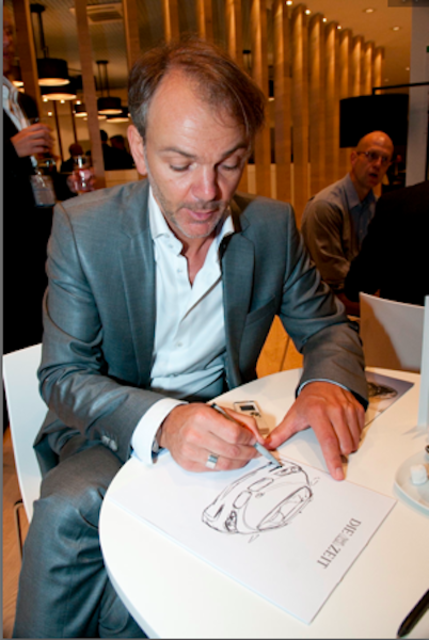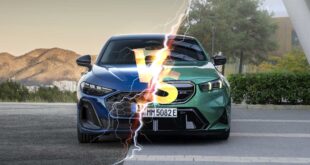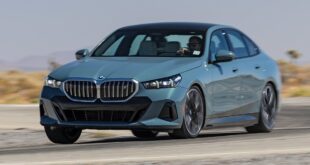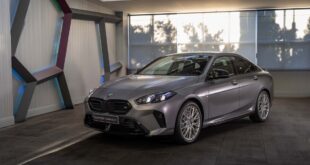 Adrian van Hooydonk sat down with Sympatico.ca in Frankfurt Germany to talk about how to draw cars. The Director of BMW Group Design talks about choosing the right tools, the flow of design, working with engineers, evolution of green design, the complete design process, and even taking responsibility for controversy. Here is an excerpt of the interview.
Adrian van Hooydonk sat down with Sympatico.ca in Frankfurt Germany to talk about how to draw cars. The Director of BMW Group Design talks about choosing the right tools, the flow of design, working with engineers, evolution of green design, the complete design process, and even taking responsibility for controversy. Here is an excerpt of the interview.
On choosing the right tools
“I leave the designers free to choose their own tools. And over time you develop your own style and your favourite tools. It’s all about coming up with good ideas, and I don’t want to tell the designers what to think, and how to think it, and how to sketch it. They should come up with good ideas. That’s what matters most.â€
“I like this kind of perspective. It would, lets say, be what you would see in the rearview mirror,†he says, looking up from the sketch only occasionally. “For BMW, I think it’s important. We call it ‘overtaking prestige’ – and you want it. You have good brakes, but you don’t want to use them when you’re on the Autobahn – that’s the idea.â€
On flow
“To do a design you can’t just sit there and think it all up in your head and sketch it. It’s not like that, like a mathematical problem that you have to work out in your head and then you write down the solution. It is something that you have to get into this state of… yeah, some call it flow or whatever, where you have all the things in your head that you want to do or solve, but then you have to maybe almost forget about them and start sketching. And then it will come.â€
On knowing when to stop
Hooydonk’s sketch is looking pretty finished, but he keeps adding shadows and details and fleshing it out.
“Oh, yeah, this is the danger. If I continue this then I will ruin it. But, okay, like I said, it’s hard knowing when to stop. Some designers do it all in one go. But for the most part, it’s an iterative process. You do a sketch, you go home, you do another sketch, or 10 sketches or 100 sketches until late at night. You think you’ve got it all figured out and next morning, you come in and you look at it, and you’re like, ‘no, that’s not right.’ And you start changing again. But that’s normal.â€
On the most interesting phase of the design process
“The most interesting phase in a design program is when you go from 2D, from sketch, to the 3D. It comes alive.†He motions towards his sketch. “Here you are dealing with lines in two dimensions. That’s fairly easy. When you have that same line on the bonnet of a car, it curves this way, it curves that way in all directions. And then, it’s much harder to control that curve. You have to control the curve precisely because you want to have tension from every viewing angle. It should never have a wriggle or something like that, or it should never look saggy or you know, lazy.”
On working with the engineers
“It’s not difficult to work with the engineers because they are all highly motivated people that love cars at BMW. And, they want the car to be beautiful in the end. They want to take it home and show it off to their family and say, ‘I worked on this.’ And if the family says, well…. You know, then they have a lot to answer to. So, you know, they want to help us in a sense.â€
On controversy, taking responsibility, and Bangle
Many of the same critics who bashed Bangle and applauded Hooydonk fail to realize it was Hooydonk who actually penned many of those designs – including the much ridiculed “Bangle Butt†rear end of the 2002-2008 7 Series.
“Yeah, I drew it,†Hooydonk says. “I think that it moved the game on. I think that it moved BMW on. I am happy that those cars sold well. I am aware that it was criticized, as well.â€
“[Bangle] had to take responsibility because when you’re the boss you take the responsibility. That’s just the way it is. I’m in this roll now. So whatever happens under Mini, Rolls-Royce and BMW, I get the praise or I get the criticism. The praise I give to the team, the criticism I guess stays with me. That’s the way it works.â€
“But, what I learned from it was that the BMW brand is something that we don’t own. It is so well known that it has become part of the public domain. And it means that everybody, even people that don’t buy our products, has an opinion or a feeling towards this brand. This is actually a good position to be in. There’s many brands that people don’t care about.â€
On the state of design and the evolution of green
“By nature, I’m an optimist. I always think we can make things better. That’s sort of what drives you as a designer. Otherwise, you couldn’t design yourself out of a paper bag, lets say. So, in that sense, I see now a lot of technological changes and as a result, I see more opportunity to do different or new types of vehicles.â€
He uses the upcoming i3 and i8 as examples. Both hybrids (one city car, the other a pure sports car) use a singular carbon-fibre monocoque frame on top of a metal chassis that hold the batteries.
“The market opportunity will be premium electric mobility. What do we need to do? Our engineers then came up with carbon-fibre structure, big wheels – it led to a completely different architecture and we did this design, which is I think very futuristic and radical.â€
“Design can communicate so much. Design can even communicate what kind of technology is underneath without really people having to dig deep into how it really works.†(You can see the cars for yourself in our gallery above.)
 BMW.SG | BMW Singapore Owners Community The Ultimate BMW Community – Established Since 2001
BMW.SG | BMW Singapore Owners Community The Ultimate BMW Community – Established Since 2001













